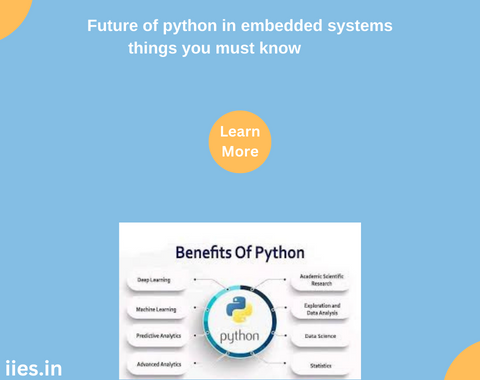
Python, a versatile and powerful programming language renowned for its simplicity and readability, has been making significant strides in the realm of embedded systems. Traditionally, embedded systems have been dominated by languages like C and assembly due to their efficiency and low-level control. However, Python’s ease of use, extensive libraries, and growing ecosystem are reshaping the landscape, offering new possibilities and efficiencies in embedded development. In this article, we’ll explore the future of Python in embedded systems and what developers need to know about this evolving trend.
1. Python’s Growing Presence in Embedded Systems:
Python’s popularity and adoption have been steadily increasing across various domains, including embedded systems. Its versatility and ease of learning make it an attractive choice for developers, even in resource-constrained environments typical of embedded systems. Additionally, the availability of microcontroller-friendly versions of Python, such as MicroPython and CircuitPython, has further facilitated its use in embedded development.
2. Efficiency Improvements and Optimizations:
One of the primary concerns with using Python in embedded systems has been its perceived inefficiency compared to lower-level languages like C. However, ongoing efforts to optimize Python for embedded platforms have yielded promising results. Projects like PyPy and Cython aim to improve Python’s performance by introducing just-in-time (JIT) compilation and static typing, respectively, thus making it more suitable for resource-constrained environments.
3. Integration with Hardware and IoT Devices:
Python’s rich ecosystem of libraries and frameworks extends to the realm of hardware and IoT devices, enabling seamless integration with sensors, actuators, and other peripherals. Libraries like Adafruit CircuitPython provide high-level abstractions for interacting with hardware components, simplifying the development process for embedded systems and IoT applications. Furthermore, Python’s support for asynchronous programming with frameworks like asyncio makes it well-suited for handling concurrent tasks in IoT environments.
4. Rapid Prototyping and Development:
The ease of writing and debugging code in Python makes it ideal for rapid prototyping and iterative development in embedded systems. With Python, developers can quickly test ideas, experiment with different algorithms, and iterate on designs without the overhead of manual memory management or complex build systems. This accelerated development cycle not only reduces time-to-market but also fosters innovation in embedded system design.
5. Community Support and Documentation:
Python’s vibrant community and extensive documentation are invaluable resources for embedded developers. From online forums and tutorials to open-source projects and collaborative platforms, there is a wealth of knowledge and support available for those exploring Python in embedded systems. Community-driven initiatives like the CircuitPython project exemplify this collaborative spirit, providing a platform for sharing code, designs, and best practices in embedded development.
6. Challenges and Considerations:
Despite its many advantages, using Python in embedded systems does pose some challenges and considerations. Chief among these is the overhead associated with running a high-level interpreted language on resource-constrained devices. While optimizations can mitigate this overhead to some extent, developers must carefully assess the performance trade-offs and suitability of Python for their specific embedded application.
7. Memory and Resource Constraints:
Embedded systems often operate under tight memory and resource constraints, requiring careful management of both code and data. Python’s dynamic typing and automatic memory management can incur overhead in terms of memory usage and execution time, particularly on devices with limited RAM and storage capacity. Developers must be mindful of these constraints and optimize their code accordingly to ensure optimal performance in embedded environments.
8. Security and Reliability:
Security and reliability are paramount in embedded systems, especially in applications where safety-critical operations are involved. While Python offers robust features for software development, including built-in error handling and exception mechanisms, its dynamic nature can introduce vulnerabilities if not properly managed. Developers must adhere to best practices in secure coding and follow established guidelines for writing safe and reliable code in Python.
9. Future Trends and Innovations:
Looking ahead, the future of Python in embedded systems appears promising, driven by ongoing advancements in language optimization, hardware integration, and community collaboration.
In conclusion, Python’s emergence as a viable programming language for embedded systems heralds a new era of innovation and efficiency in embedded development. While challenges remain in terms of performance optimization and resource management, the benefits of using Python—such as rapid prototyping, hardware integration, and community support—far outweigh these concerns. By leveraging Python’s strengths and addressing its limitations, developers can harness the full potential of embedded systems to create smarter, more interconnected devices for the future. As we navigate this evolving landscape, staying informed about the latest trends and technologies in Python and embedded systems will be crucial for success in this dynamic field.
Indian Institute of Embedded Systems – IIES